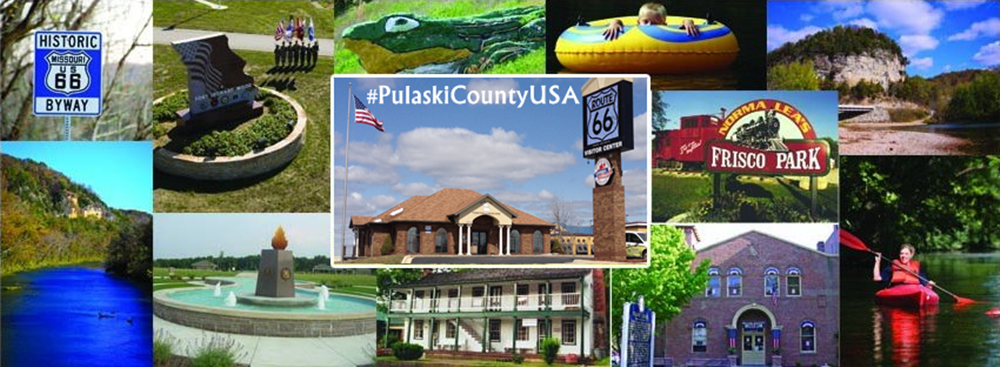By Laura Huffman
As any soldier, sailor, airman, or marine will relate, a USO sign is a welcome sight. Pulaski County historian Terry Primas summarizes in his 2005 Old Settlers Gazette article that the familiar logo is a “beacon of comfort” for service members and their families and it continues to “signal support for men and women in service to their country.”
Primas writes:
“Local communities found the USO to be their avenue for participation in the war effort during World War II. U.S. troop strength grew from 50,000 in 1940 to 12 million in 1944. USO clubs sprang up in more than 3,000 communities, as the centers became a ‘Home Away from Home.’ The clubs were volunteer driven and by the end of WWII, more than 1.5 million citizens had served doughnuts and coffee, helped write letters, danced, or simply talked to lonely GIs.”
Waynesville, Missouri had a front row seat to the massive buildup of troop strength in the days leading up to and during the duration of World War II. The Seventh Corps division had located a large military training installation just two miles southeast (as the crow flies) from the courthouse on the town’s public square.
The influx of soldiers into the rural farming community quickly revealed a need for recreation for the men stationed at Fort Leonard Wood. According to Primas:
“A campaign to establish the USO in the Fort Leonard Wood area began in March of 1941. As the military was still segregated, plans called for separate clubs for White and ‘Colored’ soldiers. Space for a Service Center for white soldiers was secured in the Knights of Pythias Hall in Rolla. In August of 1941, Ruth Chambers, Y.W.C.A. Director of Fort Leonard Wood Area, and Sara Long, Negro U.S.O. Director, attempted to establish a Negro club in Rolla. However, no landlord would rent them space for a colored club. Mrs. Long relocated to Lebanon where she established a club in a tent about a mile east of town. Subsequently, land was purchased in Old Town in Lebanon and the government erected a building for the Negro club. It was the first U.S.O. building dedicated in the area. The following year, a Negro club was built in Rolla and operated by the National Catholic Community Service.”

Image via 2005 Old Settlers Gazette
At Waynesville, the new U.S.O. building for whites was dedicated March 7, 1942. Primas recounts Mrs. Chambers description:
“a beautiful California type building—a new building, stucco, all one floor. The main lobby is two stories high with a penthouse, which was originally designated as the Jewish wing.”

Image via 2005 Old Settlers Gazette
The next day, March 8, 1942, Sterling Chavis (director of the club), Post Commander LTC. F.H.L. Ryder and others dedicated the U.S.O. Club for colored soldiers just outside the main gate of Fort Leonard Wood in unincorporated Pulaski County. No descriptions of the club have been located thus far. It is known that the location of the club and the building became Chimney Trailer Park and then later Chimney Pawn & Gun after Earl Livingston purchased it in 1951. Primas reports that the building was subsequently torn down and Mr. Carney, of Rolla, salvaged building materials to use in the construction of the Manor Inn.

Image via 2005 Old Settlers Gazette
For almost six decades the lonely remaining chimney marked the former location of the Colored U.S.O. Club. After Earl Livingston passed away in 1980 and after the death of Earl’s son, James R. Livingston in 1996, the chimney was donated to the City of Saint Robert. In an effort spearheaded by (then) St. Robert Mayor George Sanders the chimney was dismantled November 2009 and placed in storage to be reassembled at another location. George Sanders died in 2016, before the project was completed.

This view of the chimney in its original location was captured by Laura Huffman October 2009. The approximate coordinates are 37.799113, -92.138011.
However, his vision was carried out by St. Robert Historical Preservation Committee. July 11, 2017 a groundbreaking ceremony was held at the future home of the reassembled chimney. Dr. Charles Slider, Waynesville Mayor Luge Hardman, Saint Robert Mayor George Lauritson, Kevin Curtis, Frank Aterbert, Julius Nutter, Representative Steve Lynch and Walter Reese each turned a shovel of dirt for the observance. Work progressed and the chimney was reconstructed using its original bricks. Reassembly of the chimney was completed, and a dedication was held October 19, 2018.

The Ground Breaking ceremony was held July 11, 2017. Image by, and courtesy of, Waynesville-St. Robert Chamber of Commerce.

Rendering of the Negro U.S.O. Club Chimney Memorial in Saint Robert, Missouri upon completion.
Today, the chimney is a daily reminder of the United States military’s segregated past and a tribute to the African-American soldiers who endured segregation while in service to their country. President Harry S. Truman issued Executive Order 9981 ending racial segregation in the military July 26, 1948.

Completed Negro U.S.O. Club Chimney Memorial on Missouri Boulevard in Saint Robert, Missouri. Image by Beth Wiles for Pulaski County Tourism Bureau.









